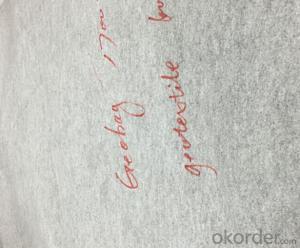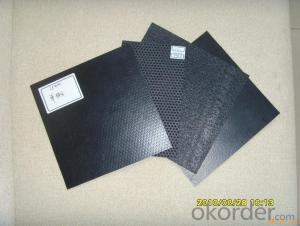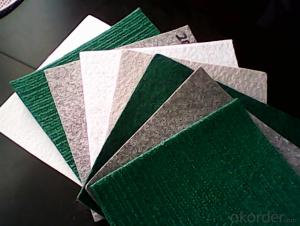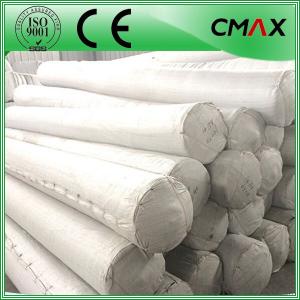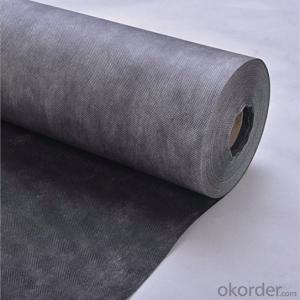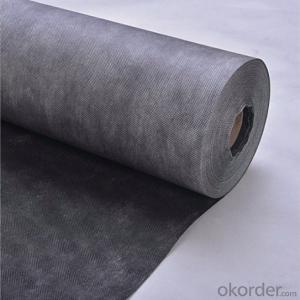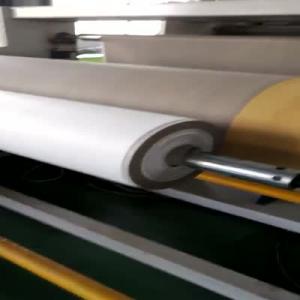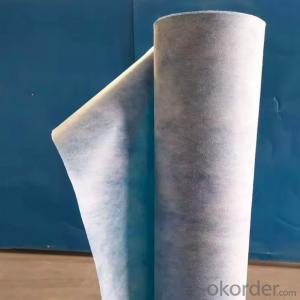Staple Fiber Needle Punched Geotextile/Non-Woven Geotextile
- Loading Port:
- Tianjin
- Payment Terms:
- TT OR LC
- Min Order Qty:
- 5000 g/m²
- Supply Capability:
- 100000 g/m²/month
OKorder Service Pledge
OKorder Financial Service
You Might Also Like
Packaging & Delivery
| Packaging Detail: | ROLLED IN PLASTIC BAG |
| Delivery Detail: | 3-5 DAYS |
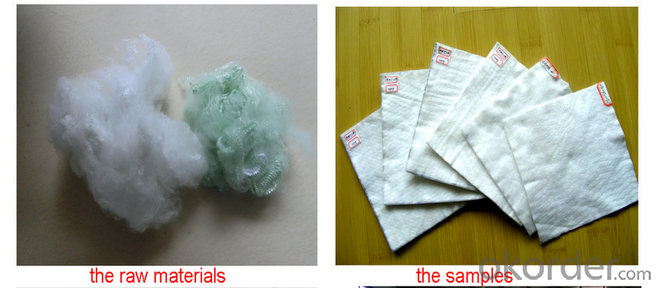
Specifications
it prevents the bank from being washed out ,protects the bank and the bottom prevents the water and soil from being washed away.
Application of geotextiles
Filtration
Separation
The isolation of the railway dregs and the roadbed, roadbed and the soft base, surface of the airdrome and parking lot and the groundsill, different dam materials. It isolates the soil and the gravel of two kinds different
granule pathway from the groundsill or other buildings.
Reinforcement
The highway, railway, soil-stone dam, breakwater, airport, backfill soil of retaining wall, slope protection, etc in which distributes the earth stress, prevents the side-displacement of the earth body and improves the earthbody stability.
Protection
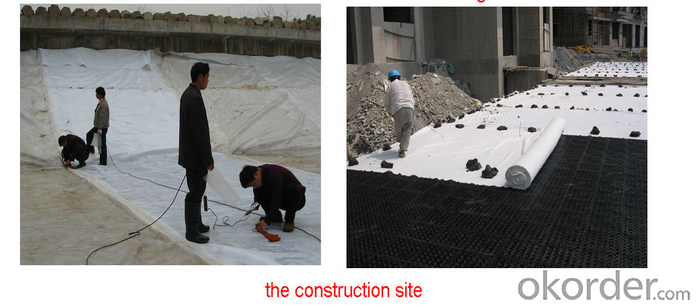
1.Product introduction of geotextile:
1.Nonwoven geotextiles are multi-purpose fabrics that are felt-like in appearance.
2.Nonwoven Geotextiles are available in varying strengths and thicknesses to ensure appropriate material 3.selection for your project. Custom roll sizes are also available.
4.Nonwoven geotextiles have a wide range of applications in civil environmental engineering and construction projects.
2.Its usage of geotextile:
1 Filtration of soils in drainage applications by retaining soil particles while allowing for the free flow of water
2 Separation and stabilization in road and railway construction
3 Prevention of soil movement in erosion control measures
4 Cushioning and protection in many containment projects
FAQ:
♦ Payment terms: by T/T or L/C |
♦ MOQ:2000 SQM |
♦ If you are interested in our products ,pls advice me the technical index,product weight etc,the more information the better..... |
- Q:What can the geotext crushed material be used?
- Can continue to be used to do geotextile, but because the geotextile after the strength of the fiber is affected, can only be crushed after the geotextile for the production of low grade geotextile, for example, the national standard geotextile crushed material can generally be used Non-standard geotextile production, but in strict accordance with the proportion of added, should not add too much crushed material.
- Q:What are the advantages of using geotextiles in mining operations?
- There are several advantages of using geotextiles in mining operations. Firstly, geotextiles act as a reliable separation barrier between different layers of soil, preventing the mixing of materials and improving the stability of the mining structures. Secondly, geotextiles provide effective filtration, allowing the passage of water while retaining fine particles, which helps in controlling erosion and maintaining water quality. Additionally, geotextiles enhance drainage systems by promoting the flow of water away from the mining area, reducing the risk of flooding and soil saturation. Lastly, geotextiles are durable and resistant to chemicals and UV degradation, ensuring long-term performance in harsh mining environments. Overall, the use of geotextiles in mining operations can improve safety, environmental protection, and the overall efficiency of the mining process.
- Q:Do you have to have a mattress on the geotextile?
- 1, geotextile must be washed back to fill or sand protective layer and light compaction to prevent the subsequent construction of the destruction of geotextile, punctured and so on. But also a transition zone, to ease the upper load on the geotextile extrusion, tensile force and so on. 2, "Geotextile Construction Code QB / SNGSG-2004" and "Geosynthetics Application Technical Specifications GB / T-2017" backfill requirements: 1) timely backfill materials, backfill stone maximum drop of not more than 300mm, Heavy earth stones should not roll on the slope of the rolling; 2) fill the compaction should meet the design requirements, backfill 300mm loose layer, light compaction. 3, geotextile introduction: 1), geotextile by synthetic fiber through acupuncture or weaving made of permeable geosynthetics. Finished cloth for the cloth, the general width of 4-6 meters, the length of 50-100 meters. Geotextile is divided into a woven geotextile and non-woven geotextile. Advantages: geotextile with excellent filtration, drainage, isolation, reinforcement, anti-seepage, protection, with a light weight, high tensile strength, good permeability, high temperature, resistance to Freezing, anti-aging, corrosion-resistant advantages. 2), Disadvantages: in the rigid base waterproof requirements are not applicable (tensile rate does not meet the requirements), easy to break, scratches and so on.
- Q:Can geotextiles be used in landfill applications?
- Yes, geotextiles can be used in landfill applications. Geotextiles are commonly used in landfill liners and caps to provide separation, filtration, and drainage functions. They help to prevent soil erosion, control water flow, and enhance the overall stability and longevity of landfills.
- Q:How are geotextiles affected by mechanical stress?
- Geotextiles are significantly affected by mechanical stress as they undergo deformation and potential damage due to external forces or loads. The stress can cause the geotextile to stretch, tear, or even rupture, affecting its overall performance and functionality. Therefore, it is essential to consider the mechanical stress factors when designing or implementing geotextile applications to ensure their long-term durability and effectiveness.
- Q:What types of geotextiles are suitable for reinforcement purposes?
- There are several types of geotextiles that are suitable for reinforcement purposes, including woven geotextiles, non-woven geotextiles, and knitted geotextiles. These geotextiles are designed to provide strength, stability, and durability when used in soil stabilization, erosion control, and retaining wall applications.
- Q:Measured geotextile vertical permeability, "highway engineering geosynthetics test procedures" T1141-2006 6.3 balanced head difference is not necessary to balance the 50mm? Can not balance ah more
- So deep, although we produce geotextile, but geotextile detection really is not proficient in it
- Q:Acupuncture geotextile is divided into several kinds of how is it used?
- Acupuncture geotextile is now divided into two types, according to the fiber form to points. Continuous fiber called filament acupuncture non-woven geotextile. A few centimeters of length fibers made of staple fibers for nonwoven geotextiles. Use is not used, mainly used in geotechnical engineering in the filter, isolation, drainage and so on.
- Q:How do geotextiles help with soil confinement in erosion control tubes?
- Geotextiles provide soil confinement in erosion control tubes by acting as a barrier that holds the soil in place, preventing its movement and erosion. They create a stable environment for the soil, allowing vegetation to grow and roots to anchor the soil, further enhancing erosion control efforts.
- Q:How are geotextiles used in erosion control?
- Geotextiles are used in erosion control by providing a protective barrier against soil erosion. They are placed on the ground surface or buried within the soil to prevent or minimize the loss of soil particles due to water flow or wind. Geotextiles help stabilize the soil by improving its strength and reducing the movement of sediments, thus preventing erosion from occurring.
1. Manufacturer Overview |
|
|---|---|
| Location | |
| Year Established | |
| Annual Output Value | |
| Main Markets | |
| Company Certifications | |
2. Manufacturer Certificates |
|
|---|---|
| a) Certification Name | |
| Range | |
| Reference | |
| Validity Period | |
3. Manufacturer Capability |
|
|---|---|
| a)Trade Capacity | |
| Nearest Port | |
| Export Percentage | |
| No.of Employees in Trade Department | |
| Language Spoken: | |
| b)Factory Information | |
| Factory Size: | |
| No. of Production Lines | |
| Contract Manufacturing | |
| Product Price Range | |
Send your message to us
Staple Fiber Needle Punched Geotextile/Non-Woven Geotextile
- Loading Port:
- Tianjin
- Payment Terms:
- TT OR LC
- Min Order Qty:
- 5000 g/m²
- Supply Capability:
- 100000 g/m²/month
OKorder Service Pledge
OKorder Financial Service
Similar products
New products
Hot products
Hot Searches
Related keywords








